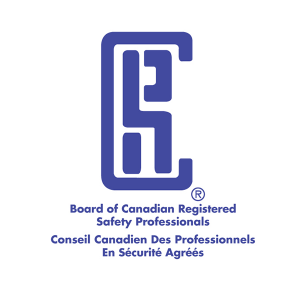Find out what it takes to get your career off the ground.
Occupational Health and Safety Officer Program
This program is approved by the Board of Canadian Registered Safety Professionals (BCRSP). Graduates are eligible for national certifications. Become a certified Health and Safety Officer in just 12 months.
What’s Your Role as a Health and Safety Officer?
Occupational health and safety officers play an important role in keeping workers safe across Ontario. Their responsibilities include:
- Doing health and safety inspections to ensure management and workers are following the law
- Identifying risks and safety hazards
- Delivering health and safety training programs
- Establishing health and safety procedures
- Investigating accidents, complaints, and injuries
- Following up on disability claims
- Dealing with the Worker’s Compensation Board
- Developing fire evacuation plans and other emergency procedures
- Reporting companies who are not compliant with health and safety legislation (penalties include fines and/or imprisonment)
- Developing plans to continuously improve workplace health and safety
Herzing College Occupational Health and Safety Officer Program
Herzing’s Occupational Health and Safety Officer program fully prepares students for entry-level health and safety jobs. We teach the legislation, theory, and practical skills needed to minimize accidents and injuries in the workplace.
- 12-month diploma program (20 hours per week)
- Approved by the Board of Canadian Registered Safety Professionals (BCRSP)
- Graduates are eligible for the Canadian Registered Safety Technician Certification (recognized across Canada and required by many employers)
- 12-week internship
- Financial assistance available for those who qualify
- On campus, online, and hybrid learning options
- Multiple start dates throughout the year
Certification Opportunities for Herzing Health and Safety Graduates
Herzing’s Occupational Health and Safety training is approved by the Board of Canadian Registered Safety Professionals (BCRSP). This means our graduates are eligible to apply for certification with the BCRSP.
There are 2 levels of certification:
1. Canadian Registered Safety Technician (CRST). Herzing graduates can apply for CRST certification immediately after finishing the program.
2. Canadian Registered Safety Professional (CRSP). Herzing graduates can apply for CRSP certification after gaining 4 years of work experience in the field.
Articulation Agreement with Columbia Southern University
An articulation agreement allows for the transfer of a limited number of credits to an associate or bachelor’s degree program in Occupational Health & Safety offered by Columbia Southern University situated in the USA.
Career Outlook
There is steady demand for occupational health and safety officers throughout Ontario and across Canada. Companies need skilled professionals to conduct inspections, deliver training, and ensure compliance with health and safety legislation.
Many types of companies and organizations hire health and safety officers, including:
- Government agencies
- Insurance companies
- Hospitals and other healthcare providers
- Universities, colleges, and other educational institutions
- Factories and manufacturing plants
- Transportation companies
- Construction companies
Job Opportunities for Occupational Health and Safety Graduates
Graduates of our Occupational Health and Safety Officer program will find job opportunities in both the private and public sector. Common job titles include:
- Health and Safety Assistant
- OHS Administrator
- OHS Coordinator
- Health and Safety Officer
Study Topics
This program teaches the skills you need to become a certified Health and Safety Officer. Study topics include health and safety legislation, how to deliver safety training, risk analysis, worker health and wellness, and disability management.
Click to see a detailed description of courses.
This course is intended to teach students the basics of recognizing and addressing safety hazards in the workplace. Topics will include performing job function analyses, design issues, equipment safety, hazardous materials handling, WHMIS, tool safety, and working in the presence of robotics or autonomous equipment..
This course is intended to teach students the basics of performing a safety audit and analysis of the results. Topics include auditing principles, evaluation of management systems, the role of an auditor, internal vs. external audits, performing inspections, interviews and developing an action plan
This course is intended to teach students the basics of fire prevention and protection as well as addressing other environmental hazards. Topics include emergency procedures, safety codes/standards, fire chemistry/behaviour, hazardous spill management, and fire control systems.
This course is intended to teach students the fundamentals of arranging workspaces to allow staff to work safely and efficiently within them. Students will learn about the dangers of repetitive stress injuries, improper posture, and how to assess workspaces in terms of ergonomic design.
This course is intended to teach students the basics of body functions and processes in the context of prevention of illness and injury. Topics include anatomy and physiology, toxicology, chemical hazards, physical hazards, and air quality
This course is intended to teach students the fundamentals of the promotion of wellness and overall health in the workplace. Topics include injury and disease prevention programs, disability management programs, and work factors that can impact worker well-being.
This seminar provides an opportunity for the student to apply the techniques and processes for developing a career path and to learn lifetime career management tools and skills. Topics include career-planning, job searching, developing career search documents, refining interview skills, and preparing for a new position.
This course is intended to teach students the basics of the applicable safety legislation and legal requirements. Topics include the basic principles of law, occupational health and safety laws in Canada, environmental legislation, ethical theories, worker rights, and the role of the board of Canadian Registered Safety Professionals.
This course is intended to teach students the fundamentals of management’s role in workplace health and safety. Topics include the integration of health and safety into organizational structure, quality management systems, conflict management, leadership styles, and strategic planning.
This course is intended to teach students the basics of risk management. Topics include risk assessment, the risk control process, monitoring and reassessment, emergency preparedness, incident command systems, and workplace harassment/violence prevention.
This course helps the new OHS professional develop the critical skills to effectively communicate with all stakeholders in an organization regarding health and safety requirements. Critical thinking, writing effective policy and training documents, as well as speaking persuasively will all be covered.
This course guides the student through the process of developing training materials for staff and other stakeholders. All phases of the development from planning, materials creation, delivery of training, and measuring training effectiveness will be included.
This course covers the role of the Worker’s Compensation Board as well as other legislation that addresses disabilities caused in or out of the workplace. The process of submitting a claim, the role of OHS professionals in applying for/managing the disability case, appropriate communications with specific agencies, and the applicable legislation will be covered.
This course helps students understand reporting requirements as well as which stakeholders need which reports. The legislation regarding records, preparing reports to stakeholders, recording workplace performance data, and facilitating/recording meeting proceedings will be covered.
The internship component of the program is the practical application of a student’s knowledge and skills in a business environment. The company shall provide work that is directly related to the student’s program of study. The duration of the internship is twelve weeks during which the student must satisfactorily complete a minimum of 240 hours of work experience.
 Instructors
Instructors
I’m a professional chemical engineer with a Master’s in Engineering Management and 15+ years of experience in fertilizer, refinery, energy, power, and water treatment plants. I hold the following HSE qualifications:
▪ Canadian Registered Safety Professional (CRSP) from BCRSP, Canada.
▪ Certified Safety Professional (CSP) from BCSP, USA.
▪ Certified Electrical Safety Compliance Professional (CESCP) by NFPA, USA.
▪ Certified Fire Protection Specialist (CFPS) by NFPA, USA.
▪ Lead Auditor QMS ISO 9001, EMS 14001 & OHSMS 45001 by CQI/IRCA, UK.
I have specialties in safety training, HAZOP, safety culture improvement through behavioural-based safety (BBS), job safety analysis (JSA), incident investigation & root cause analysis, hazard identification & risk assessment, safety-critical devices management, management of change (MOC), pre-startup safety review (PSSR), contractor safety management, process safety, and implementation of HSE management systems.
I love to travel and explore nature. So far, I have travelled across 14 countries. I enjoy teaching so I can make a difference in someone’s life and help them to become a proficient professional.
Admission Requirements
What you need to get started.
- Minimum of a Canadian high school grade 12 or equivalent (Ontario high school diploma or equivalent) or a mature student (19 years of age or older and has been removed from full-time high school for minimum 2 years)
*Students applying as mature students must demonstrate appropriate levels of math, English literacy, comprehension and/or written skills to warrant success and completion of program - Pass an entrance test administered by Herzing College
- Be interviewed in detail regarding interest in the field
- Note: admission to some programs may include additional requirements
Tuition and Fees
Please click for information on program tuition and fees
Overview
CAMPUS
INDUSTRY
Business
PROGRAM LENGTH
12 Months (20 hours/week)
Includes 12 week internship
LEARNING MODALITIES
On Campus, Online, Hybrid
EXPLORE CAREERS
TRY OUR CAREER EXPLORATION KIT
Our online kit takes 3-minutes to complete and you’ll get a personalized report. Identify your strengths and social style plus the training and positions you’re best suited for.

2022 Overall Graduate Employment Rate
88% of available Herzing College Toronto graduates were employed in a related field.
*statistics based on most recent available
Career Infographic
Not sure what to expect after graduating? Download our career infographic and discover your pathway to a happy career.
Your Next Steps
Ready to learn more the Occupational Health and Safety Officer diploma program? It’s easy to get started. Choose from the following options:
- Fill out the form to ask questions via email
- Chat live with an Admissions Advisor to get your questions answered now
- Click Request Information to get your application started today!
Why Choose this Program?
- Accelerated 12-month program that gets you to work faster
- Option to study online through the Herzing College Winnipeg campus
- Preparation to earn the CRST certification (which opens up better jobs and higher salaries)
- Intensive 12-week internship that gives you real work experience for your resume (and the chance to get hired)
- Access to the Herzing Open Education Program (HOEP), which lets you take additional courses after you graduate, tuition-free!
- Exceptional Career Development team, who helps create your resume, prepare for interviews, and apply for health and safety officer jobs




